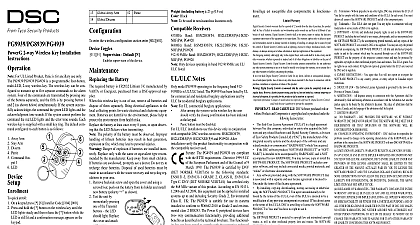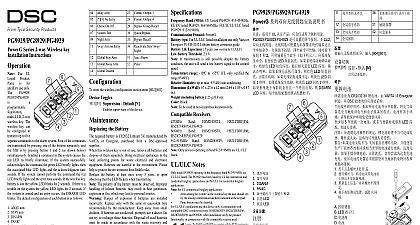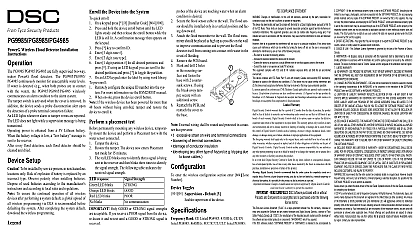DSC PG9938-PG8938-PG4938 - Wireless PG Pantic Key - Installation Manual - ENG - S-CHI - R001

File Preview
Click below to download for free
Click below to download for free
File Data
| Name | dsc-pg9938-pg8938-pg4938-wireless-pg-pantic-key-installation-manual-eng-s-chi-r001-1048576329.pdf |
|---|---|
| Type | |
| Size | 1.41 MB |
| Downloads |
Text Preview
PG9938 PG8938 PG4938 Panic Button Installation 000 Hazard Small parts The pendant and belt are NOT for children under 3 years not submerge the wireless key in any liquid as it damage the electronic circuits Keep this manual for future PG9938 PG8938 PG4938 is a panic button Confirmation a successful transmission is indicated by the LED light Setup quick enroll On a keypad press 8 Installer Code Press and hold the button on the wireless key the LED lights steady and then release button while the LED is still lit and a confirmation mes appears on the keypad Press key to confirm ID Enter 3 digit zone Enter 2 digit zone type Enter 1 digit partition for all desired partitions and press If using a menu based configuration you can scroll to the partitions and press to toggle the partition On an LCD keypad enter the label by using word library pre enroll Remotely configure the unique ID number into the system more information see the HSM2HOST manual When on site press the device enroll button enter the wireless configuration section enter 804 601 Toggles Supervision Default N supervision of the device to a Belt Clip Slide the device into the holder until you feel it snap To attach the belt clip slide it onto the rails on the rear of the inside Align the holder on a wall facing up illustrated Using two 4 5 8 screws and wall anchors secure the to the wall Slide the device into the holder until feel it snap securely inside To remove the device from the pinch the clasps Modifications to this wireless key not expressly by the party responsible for compliance may void the authority to operate it the Battery required battery is CR2032 Lithium 3V manufactured by or Energizer purchased from a DSC approved sup this wireless key is out of use remove all batteries and of them separately Bring electrical appliances to the collecting points for waste electrical and electronic equip Batteries are harmful to the environment Please help to the environment from health risks the battery at least once every 5 years or upon observ that the LED flickers when transmitting The polarity of the battery must be observed Improper of lithium batteries may result in heat generation or fire which may lead to personal injuries Danger of explosion if batteries are installed Replace only with the same or equivalent type rec by the manufacturer Keep away from small chil If batteries are swallowed promptly see a doctor Do not to recharge these batteries Disposal of used batteries must made in accordance with the waste recovery and recycling in your area To replace the battery insert a coin into the slot on the bot of the unit and twist it open Make sure the elastic pad within the cover remains in Put it back in place if it falls off Extract the old battery from its holder and replace it with a new battery Ensure that the plus side of the faces up attaining correct polarity Test the device by pressing the button The LED indicator Replace the covers securely verifying that the cover snaps light use of abrasives of any kind and solvents such as ker acetone or thinner is strictly forbidden the wireless key only with a soft cloth or sponge moist lightly with a mixture of water and mild detergent and it dry immediately test the system at least once per a year Ensure the device is enrolled in the system On a keypad press 8 Installer Code 904 601 632 Stand 3 m 10 ft away from the control panel and press the Verify that the transmit LED lights and the control responds as programmed Operate the pendant from various locations within the area by the receiver to determine dead locations where is blocked by walls and large objects or by structural materials If dead marginal zones are a problem relocating the may improve the performance Band CE Listed PG4938 433 CE listed PG8938 868 869.15MHz FCC IC UL listed PG9938 912 919.185MHz Protocol PowerG type For UL ULC listed installation use only Varta or 3V CR 2032 Lithium battery consumer grade Life Expectancy 5 years not verified by UL ULC Battery Threshold 2.05 V If transmission is still possible despite the battery condi the unit will send a low battery signal to the control panel Range 10 to 55 UL ULC only verified range 0 to 49 up to max 93 RH non condensing LxWxD 53 x 33 x 11 mm 2.1 x 1.3 x 0.43 in 15 g 0.5 oz including battery 20 g 0.7 oz To be used in non hazardous locations only Receivers Band HSM2HOST4 HS2LCDRF P 4 HS2IC PG4920 Band HSM2HOST8 HS2LCDRF P 8 HS2IC Band HSM2HOST9 HS2LCDRF P 9 HS2IC PG9920 Only devices operating in band 912 919MHz are UL listed Notes model PG9938 operating in the frequency band 912 are UL ULC listed The PG9938 has been listed by for residential burglary applications and by ULC for resi burglary applications in accordance with the require in the Standard UL 1023 ULC ORD C1023 Household Alarm Units UL ULC installations use these device only in conjunction compatible DSC wireless receivers HSM2HOST9 HS2ICNRF P 9 and PG9920 After installa verify the product functionality in conjunction with the receiver used The PG4938 and PG8938 are compliant with the requirements Directive 1999 5 EC of the European and of the Council of 9 March 1999 The is certified by Applica Test and Certification to the standards EN50131 3 EN 50131 6 Type C Applica Test and has certified only the 868 MHz variant of this product to EN 50131 1 2006 and A1 2009 this equipment can be in installed systems up to and including Security Grade 2 Class II UK The PG8938 is suitable for use in systems to conform to PD6662 2010 at Grade 2 and environmental class BS8243 The Power G peripheral devices have way functionality providing additional benefits as described the technical brochure This functionality has not been tested to comply the respective technical requirements and should therefore be outside the scope of the product certification COMPLIANCE STATEMENT Changes or modifications to this unit not expressly approved the party responsible for compliance could void the user authority to the equipment device has been tested and found to comply with the limits for a B digital device pursuant to Part 15 of the FCC Rules These limits designed to provide reasonable protection against harmful interference residential installations This equipment generates uses and can radiate frequency energy and if not installed and used in accordance with instructions may cause harmful interference to radio and television there is no guarantee that interference will not occur in a installation If this device does cause such interference which be verified by turning the device off and on the user is encouraged to the interference by one or more of the following measures Re orient or re locate the receiving antenna Increase the distance between the device and the receiver Connect the device to an outlet on a circuit different from the one that power to the receiver Consult the dealer or an experienced radio TV technician equipment complies with FCC and IC RF radiation exposure limits forth for an uncontrolled environment device complies with FCC Rules Part 15 and with Industry Canada RSS standard s Operation is subject to the following two 1 This device may not cause harmful interference and 2 device must accept any interference that may be received or that may undesired operation present appareil est conforme aux CNR d Canada applicables appareils radio exempts de licence L est autorisee aux conditions suivantes 1 l ne doit pas produire de et 2 l de l doit accepter tout brouillage subi meme si brouillage est susceptible d le fonctionnement cid 5316 cid 5717 cid 6457 cid 19166 cid 4537 cid 16117 cid 6455 cid 2439


